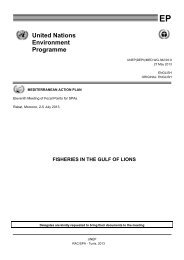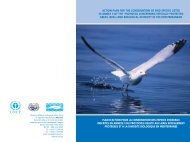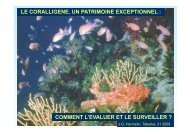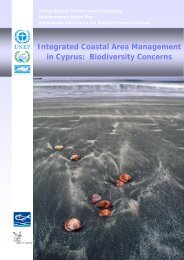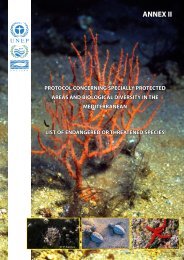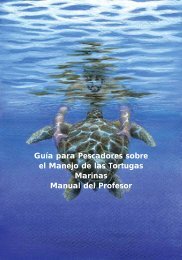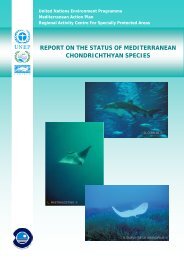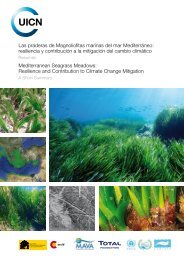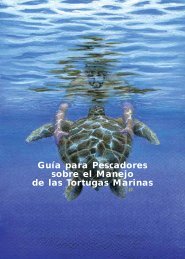Proceedings of the Second Mediterranean Symposium on Marine
Proceedings of the Second Mediterranean Symposium on Marine
Proceedings of the Second Mediterranean Symposium on Marine
You also want an ePaper? Increase the reach of your titles
YUMPU automatically turns print PDFs into web optimized ePapers that Google loves.
871 accepted taxa (Table 1). However, it should be noted that most species <str<strong>on</strong>g>of</str<strong>on</strong>g> <str<strong>on</strong>g>the</str<strong>on</strong>g><br />
Laurencia complex and <str<strong>on</strong>g>of</str<strong>on</strong>g> n<strong>on</strong>geniculate Coralline algae were <strong>on</strong>ly tentatively included<br />
in <str<strong>on</strong>g>the</str<strong>on</strong>g> accepted taxa. In fact, because <str<strong>on</strong>g>the</str<strong>on</strong>g> tax<strong>on</strong>omy <str<strong>on</strong>g>of</str<strong>on</strong>g> such groups has recently<br />
underg<strong>on</strong>e substantial reassessments, in absence <str<strong>on</strong>g>of</str<strong>on</strong>g> <str<strong>on</strong>g>the</str<strong>on</strong>g> study <str<strong>on</strong>g>of</str<strong>on</strong>g> herbarium specimens,<br />
<str<strong>on</strong>g>the</str<strong>on</strong>g> occurrence <str<strong>on</strong>g>of</str<strong>on</strong>g> most <str<strong>on</strong>g>of</str<strong>on</strong>g> such species should be c<strong>on</strong>firmed.<br />
Table 1. The macroalgal italian flora: compositi<strong>on</strong> <str<strong>on</strong>g>of</str<strong>on</strong>g> <str<strong>on</strong>g>the</str<strong>on</strong>g> whole flora, <str<strong>on</strong>g>of</str<strong>on</strong>g> floras <str<strong>on</strong>g>of</str<strong>on</strong>g> each FAO sector<br />
(sector 3: Tyrrhenian Sea and adjacent basins; sector 4: Adriatic Sea; sector 5: I<strong>on</strong>ian Sea), <str<strong>on</strong>g>of</str<strong>on</strong>g> comm<strong>on</strong><br />
species to all sectors as well as <str<strong>on</strong>g>of</str<strong>on</strong>g> sole species <str<strong>on</strong>g>of</str<strong>on</strong>g> each sector.<br />
Italy<br />
sector 3<br />
sector 4<br />
Rhodophyta 510 470 340 444 314 44 4 32<br />
58.7% 61.2% 58.9% 63.2%<br />
Phaeophyta 205 169 124 148 93 26 21 15<br />
23.6% 21.9% 21.5% 21.1%<br />
Chlorophyta 154 130 113 110 84 20 14 5<br />
17.7% 16.9% 19.6% 15.7%<br />
Total 869 769 577 702 491 90 39 52<br />
88.5% 66.4% 80.8% 56.5% 10.3% 4,5% 6.0%<br />
Since <str<strong>on</strong>g>the</str<strong>on</strong>g> Italian coasts (Fig. 1) fall within <str<strong>on</strong>g>the</str<strong>on</strong>g> FAO fishering sectors 3 (Tyrrhenian Sea and<br />
adjacent basins), 4 (Adriatic Sea) and 5 (I<strong>on</strong>ian Sea), <str<strong>on</strong>g>the</str<strong>on</strong>g> floristic c<strong>on</strong>sistency <str<strong>on</strong>g>of</str<strong>on</strong>g> each<br />
sector was calculated.<br />
The flora <str<strong>on</strong>g>of</str<strong>on</strong>g> <str<strong>on</strong>g>the</str<strong>on</strong>g> sector 3 is <str<strong>on</strong>g>the</str<strong>on</strong>g> richest with 769 taxa (470 Rhodophyta, 169<br />
Phaeophyta and 130 Chlorophyta), followed by that <str<strong>on</strong>g>of</str<strong>on</strong>g> <str<strong>on</strong>g>the</str<strong>on</strong>g> sector 5 with 702 taxa<br />
(444 Rhodophyta, 148 Phaeophyta and 110 Chlorophyta) and by that <str<strong>on</strong>g>of</str<strong>on</strong>g> <str<strong>on</strong>g>the</str<strong>on</strong>g> sector<br />
4 that resulted <str<strong>on</strong>g>the</str<strong>on</strong>g> poorest with 577 taxa (340 Rhodophyta, 124 Phaeophyta and<br />
113 Chlorophyta). The three sectors share 491 taxa (equal to 56.5%), while 90<br />
taxa (10.3%) are present <strong>on</strong>ly in <str<strong>on</strong>g>the</str<strong>on</strong>g> sector 3, 39 taxa (4.5%) in <str<strong>on</strong>g>the</str<strong>on</strong>g> sector 4 and<br />
52 taxa (6.0%) in <str<strong>on</strong>g>the</str<strong>on</strong>g> sector 5 (Table 1). In order to understand <str<strong>on</strong>g>the</str<strong>on</strong>g><br />
phytogeographic characteristics <str<strong>on</strong>g>of</str<strong>on</strong>g> <str<strong>on</strong>g>the</str<strong>on</strong>g> Italian flora, a specific investigati<strong>on</strong> <str<strong>on</strong>g>of</str<strong>on</strong>g> <str<strong>on</strong>g>the</str<strong>on</strong>g><br />
areals <str<strong>on</strong>g>of</str<strong>on</strong>g> every species has been c<strong>on</strong>ducted. Following that study, each species was<br />
assigned to a distributi<strong>on</strong>-group named according to Cormaci et al. (1982).<br />
Chorological spectra (Table 2 and Fig. 2) <str<strong>on</strong>g>of</str<strong>on</strong>g> <str<strong>on</strong>g>the</str<strong>on</strong>g> Italian flora and <str<strong>on</strong>g>of</str<strong>on</strong>g> floras <str<strong>on</strong>g>of</str<strong>on</strong>g> sectors<br />
3 and 5 are characterised by a dominance <str<strong>on</strong>g>of</str<strong>on</strong>g> <str<strong>on</strong>g>the</str<strong>on</strong>g> Atlantic element, followed by <str<strong>on</strong>g>the</str<strong>on</strong>g><br />
<str<strong>on</strong>g>Mediterranean</str<strong>on</strong>g>, Cosmopolitan, Indo-Pacific, Circumtropical and Circumboreal; <strong>on</strong>ly<br />
that <str<strong>on</strong>g>of</str<strong>on</strong>g> <str<strong>on</strong>g>the</str<strong>on</strong>g> sector 4 shows a different sequence <str<strong>on</strong>g>of</str<strong>on</strong>g> distributi<strong>on</strong> groups with <str<strong>on</strong>g>the</str<strong>on</strong>g><br />
dominance <str<strong>on</strong>g>of</str<strong>on</strong>g> <str<strong>on</strong>g>the</str<strong>on</strong>g> Atlantic element, followed by <str<strong>on</strong>g>the</str<strong>on</strong>g> Cosmopolitan, <str<strong>on</strong>g>Mediterranean</str<strong>on</strong>g>,<br />
Circumtropical, Indo-Pacific and Circumboreal.<br />
sector 5<br />
comm<strong>on</strong><br />
species<br />
sole species<br />
<str<strong>on</strong>g>of</str<strong>on</strong>g> sector 3<br />
sole species<br />
<str<strong>on</strong>g>of</str<strong>on</strong>g> sector 4<br />
sole species<br />
<str<strong>on</strong>g>of</str<strong>on</strong>g> sector 5<br />
ACTES DU DEUXIEME SYMPOSIUM MEDITERRANEEN SUR LA VEGETATION MARINE (ATHENES, 12-13 DECEMBRE 2003)<br />
57




